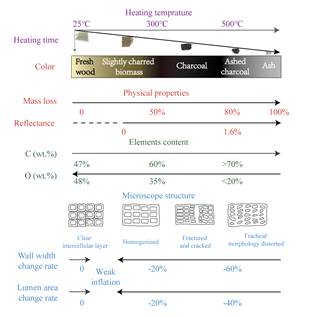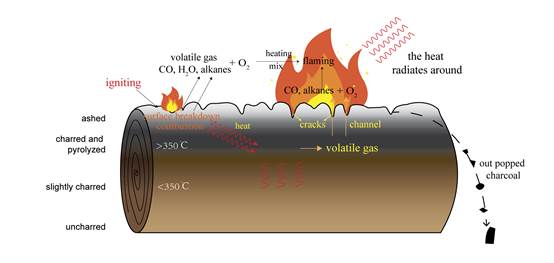Charcoal, the product of incomplete combustion of plants, is widely preserved in geological deposits and human cultural relics due to its stable chemical properties. The environmental and species information recorded by charcoal has also become an important carrier for studying paleontological evolution, paleoenvironmental evolution, and ancient human activities. However, due to the lack of systematic and quantitative extant experiments and comparative studies with charcoal in sediments, there are still great uncertainties in understanding the wood carbonization process and the interpretation of paleoenvironmental information contained in charcoal.
In response to the above problems, the environmental archaeology research team of the College of Earth and Environment Science of Lanzhou University and the Key Laboratory of Western China’s Environmental Systems (Ministry of Education) has carried out simulation control experiments on wood carbonization of two typical tree species (pine and spruce) in the northeastern region of the Qinghai-Tibet Plateau. A series of physical and chemical indicators such as mass loss, reflectivity, carbon, nitrogen, and oxygen content, wood microstructure, tracheid wall thickness, and tracheid cavity area was used to quantitatively analyze the wood carbonization process. The results show that the thickness of the tracheid wall and the area of the tracheid cavity decreased by about 20% during the wood carbonization process, the weight loss rate of the wood reached 50%, the content of carbon and oxygen elements increased and decreased to about 60% and 35%, respectively, and the reflectance increased from 0 rose to 0.5 (Figure 1). Among them, the combination of reflectivity and tracheid wall thickness can well reflect the formation temperature of charcoal. Based on this, the key physical and chemical indicators of charcoal excavated in several archaeological sites in the northeastern Qinghai-Tibet Plateau were compared and verified. It was concluded that the formation temperature of archaeological charcoal should be concentrated at 400-500 °C. Finally, by combing the definition of charcoal from different disciplinary perspectives and combining the results of this study, the general characteristics of natural "charcoal" are summarized: charcoal is the pyrolysis product of incomplete combustion of fire-related plants, and its character is black. Inert solid and readily preserved in formations and rocks, and large charcoal fragments preserve microscopic anatomical features. The carbonization process in nature refers to the process in which the combustion of wood is interrupted or smoldered at a certain temperature (>~350 °C) and is gradually transformed into a black inert solid with a complete anatomical structure. At the same time, the paper also proposes a model diagram of burning charcoal (Figure 2).
This study is the first to integrate a variety of physical and chemical indicators to quantify the wood carbonization process and propose a dual indicator of "reflectivity-tracheid wall thickness" that can restore the formation temperature of archaeological charcoal. The exploration of the design and research methods of extant controlled experiments provides a new idea for the study of the wood carbonization process, and the research of multi-index quantification also lays an important foundation for exploring the research and application of charcoal stable isotopes in the fields of paleoclimate, paleoenvironment and paleoanthropology. Base. The study is currently published online in Fundamental Research, a journal organized by the National Natural Science Foundation of China under the title of "Quantitative studies on charcoalification: Physical and chemical changes of charring wood". Li Gang, a master's student from the College of Earth and Environment Science of Lanzhou University, is the first author of the paper, and Associate Researcher Gao Linlin and Professor Dong Guanghui are the co-corresponding authors. This paper is co-funded by the National Natural Science Foundation of China (No.41825001, No.41991251) and the Second Qinghai-Tibet Plateau Scientific Expedition and Research Program (STEP) (No. 2019qzkk0601).
Article link:https://doi.org/10.1016/j.fmre.2022.05.014

Fig. 1 Changes in various indicators in the process of wood carbonization

Fig. 2 Schematic diagram of wood burning to form charcoal